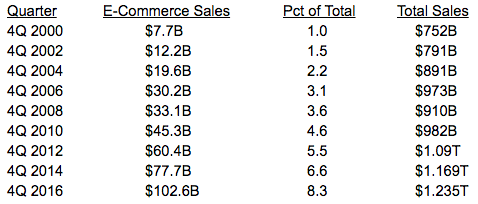(Consumer Case)

According to the United States Census Bureau, ecommerce accounted for 8.3% of all U.S. retail sales in the 4th quarter of 2016. This activity represents $102.6 billion in goods and services, out of a total $1.2 trillion.
The data shows that ecommerce, as a percentage of all commerce, is steadily growing:

Even after the financial crisis of 2007-2008 which saw a decrease in total retail sales, ecommerce activity increased both in relative and absolute terms. It is safe to assume that e-commerce will continue to grow into the foreseeable future. Some of the factors driving this trend from the vantage point of the consumer:
Price – The Internet makes it easy for the consumer to compare the price of a particular product or service from multiple sources.
Information – Product specifications and reviews are readily available online, facilitating the purchase decision.
Convenience – The consumer may browse and purchase goods anywhere he or she has an Internet connection – the home, the office, public locations with Wi-Fi access, etc. Furthermore, ecommerce is generally available every day including holidays, and at all hours of the day and night.
Efficiency – Online stores have certain efficiencies compared with traditional bricks-and-mortar stores. There is no time wasted driving to an online store, or searching for a parking space, or standing in a checkout line.
Anonymity – Some consumers avoid the public eye and, if they are self-conscious about their purchases, may prefer to shop in privacy.
The Rise of Technology – Some forms or commerce (think music sales, computer sales, and stock trading) have evolved through technology and now exist almost entirely as e-commerce. New currencies such as bitcoin encourage ecommerce.
As technology evolves, ecommerce will likely develop greater consumer benefits and become more accessible. It should therefore continue to grow as a percentage of total sales. To what extent will depend on the relative merits of traditional commerce.
